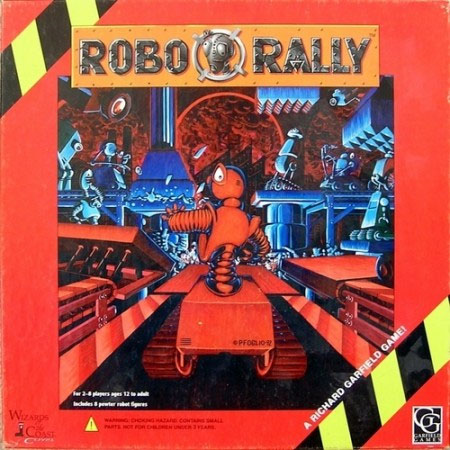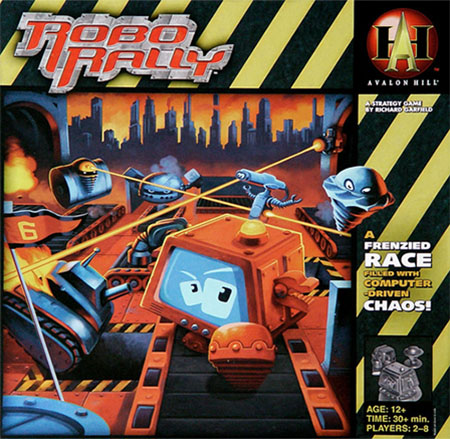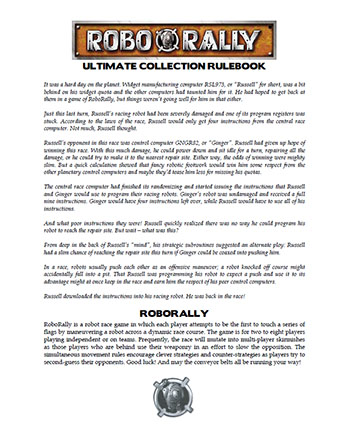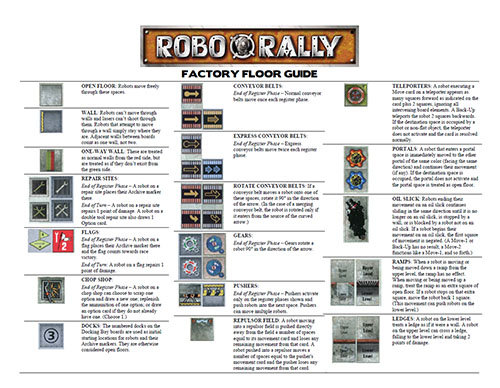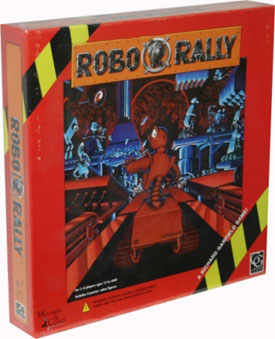RoboRally is 20 years old this year. It remains one of my favorite boardgames of all time: The combination of clever puzzle-solving, long-term strategic thinking, and half-crazed chaos is brilliantly balanced. I wrote a detailed review of the original edition of the game back in 1998.
One of the things I always wanted to do back in the day was pick up the three expansions that were released in the ’90s: Armed & Dangerous, Radioactive, Crash & Burn, and Grand Prix. Unfortunately, I was a poor high school / college student back then and I couldn’t afford to snap them up when they were released. Then, with the release of the second edition of the game, the expansions were taken out of print and immediately skyrocketed in price.
Last year, however, I decided to bite the bullet and track down all of the expansions for the game.
I also picked up a copy of the 3rd Edition published under the Avalon Hill brand in 2005: This edition replaced the metal miniatures with plastic ones and used much cheaper stock for the map boards, but significantly upgraded many of the other components. (I’m particularly enamored of the plastic flags.)
Once I had this mass of material, however, it took a little extra effort to figure out how to combine all of it together for the RoboRally: Utimate Collection. So I’d like to take a moment to share that effort with all of you. (And some of what I’ve done I think you’ll find useful even if you aren’t interested in owning an Ultimate Collection of your own.)
ASSEMBLING THE ULTIMATE COLLECTION
In order to assemble the RoboRally Ultimate Collection, you’ll need to buy:
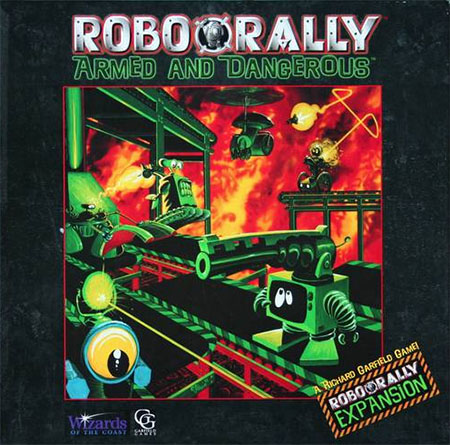 RoboRally (1st Edition)
RoboRally (1st Edition)- RoboRally (2nd Edition)
- RoboRally (3rd Edition)
- RoboRally: Armed and Dangerous
- RoboRally: Radioactive
- RoboRally: Crash & Burn
- RoboRally: Grand Prix
You will then collect from these editions:
ROBOTS: You’ll be able to use the robots from all three editions of the game (giving you a total of 24 different robots). Some of the robot models from the 1st Edition are replicated in 2nd Edition (and Twonky appears in all three editions, albeit with different sculpts). Simply paint the duplicates different colors. You’ll also want to take the Archive markers from all three editions.
GAME BOARDS: Take the game boards from the 1st Edition and 3rd Edition of the game. Then take all of the game boards from the expansions (Armed and Dangerous, Radioactive, Crash & Burn, and Grand Prix).
PROGRAM CARDS: I personally prefer the program cards from 3rd Edition.
OPTION CARDS / TOKENS: You’ll want to use the Option cards from the 1st Edition of the game and combine them with the Option cards from Armed and Dangerous. Take the option tokens from Armed and Dangerous.
FLAGS: 1st Edition used red flag chits. 2nd Edition used green flag chits. 3rd Edition uses plastic flags that stand up from the game board. The plastic flags from 3rd Edition are clearly superior, but you can actually pull the flags from all three editions if you want to run some truly insane rallies. (For example, you could run through the plastic flags, then the red flags, and then the green flags for an insane course featuring 24 rally points. Put them all on a single game board for sheer insanity.)
MISC. COMPONENTS: Take the damage tokens, Power Down tokens, and life tokens from the 3rd Edition of the game. (You’ll want to use the 3rd edition components to match the program sheets.) Also take the thirty-second timer from the 3rd Edition.
And that’s it! The tricky part these days is actually finding all of the original 1st Edition expansion sets.
ULTIMATE COLLECTION RULEBOOK
In order to wed the disparate components from across multiple editions together, I’ve also prepared the RoboRally Ultimate Collection Rulebook and the RoboRally Ultimate Collection Factory Guide. The latter pulls together the information from all of the different board element guides into a handy reference guide that you can print on a single sheet of paper. The former provides the most authoritative version of the complete RoboRally rules ever produced.
In fact, whether you can (or want) to assemble a full Ultimate Collection, I think you’ll still want to check out the Ultimate Collection Rulebook: It reorganizes and streamlines the rules while simultaneously clarifying them in order to resolve a number of vague corner-cases that none of the official rulebooks can handle properly.

